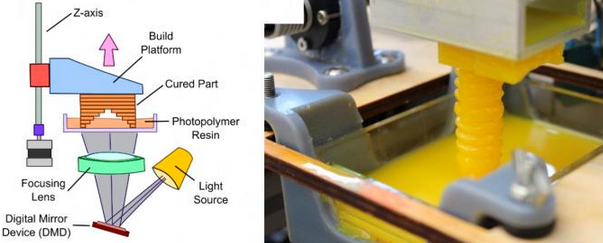3-D-printed ‘soft’ robotic tentacle with new level of octopus agility
October 19, 2015

Left: digital Mask Projection Stereolithography (DMP-SL) process; right: soft pneumatic actuator
being printed using elastomeric precursor (EP) (credit: Cornell University)
Cornell University engineers have developed a process for 3D-printing a soft robotic tentacle that mimics the complex movements and degree of freedom of an octopus tentacle.
The tentacle achieves its dexterity through a 3-dimensional arrangement of muscles in three mutually perpendicular directions (longitudinal, transverse and helical). The process uses an elastomeric (both elastic and flows) material combined with a low-cost, reliable, and simple method for 3D-printing elastomeric pneumatic actuators.
The invention is a “promising route to sophisticated, biomimetic systems,” according to Rob Shepherd, assistant professor of mechanical and aerospace engineering and senior author of a recent study published in the journal Bioinspiration & Biomimetics.
The research was funded by the Air Force Office of Scientific Research, 3M and the National Science Foundation.
Cornell University Media Relations | 3D-printed ‘soft’ robotic tentacle displays new level of agility
Abstract of 3D printing antagonistic systems of artificial muscle using projection stereolithography
The detailed mechanical design of a digital mask projection stereolithgraphy system is described for the 3D printing of soft actuators. A commercially available, photopolymerizable elastomeric material is identified and characterized in its liquid and solid form using rheological and tensile testing. Its capabilities for use in directly printing high degree of freedom (DOF), soft actuators is assessed. An outcome is the ~40% strain to failure of the printed elastomer structures. Using the resulting material properties, numerical simulations of pleated actuator architectures are analyzed to reduce stress concentration and increase actuation amplitudes. Antagonistic pairs of pleated actuators are then fabricated and tested for four-DOF, tentacle-like motion. These antagonistic pairs are shown to sweep through their full range of motion (~180°) with a period of less than 70 ms.